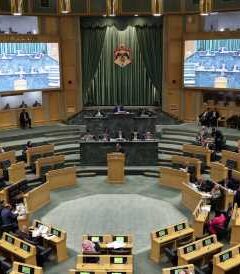Home » Middle East »
In Gaza, an Ordinary Street, and Extraordinary Horror, as Missiles Thunder In
GAZA CITY — The taxi was loaded with everything the family would need for Eid al-Fitr, a holiday of feasts and cookies and new clothes that Israeli airstrikes on Gaza have transfigured this year into a time of swooping drones and fear.
In their four suitcases, the al-Hatu family — mother, father, son, daughter — had made sure to pack kaak filled with date paste, the biscuits traditionally shared among friends and family during Eid al-Fitr, which marks the end of the fasting month of Ramadan.
But they also brought enough clothing and food for several days — no one knew when it might be safe to go back home. Until then, to try escape the airstrikes, they were going to stay with another daughter, on Al Mughrabi Street, a five-minute drive away.
They had all agreed: It would just feel safer if they were all together, said the son, Mohammed al-Hatu, 28.
They were still unloading the taxi driver’s white Skoda sedan outside their temporary home shortly before noon Wednesday when the first drone attacked.
Mr. al-Hatu’s sister had already lugged one suitcase inside. Mr. al-Hatu, who had been carrying another, staggered into the doorway of the building, bleeding, and collapsed.
Out on the street, their father, Said al-Hatu, 65, and the taxi driver lay dead. A few yards away, their mother, Maysoun al-Hatu, 58, was alive, but desperately wounded.
“Save me,” she begged Yousef al-Draimly, a neighbor who had rushed downstairs, he recounted. “I need an ambulance. Save me.”
An ambulance came, but Ms. al-Hatu did not make it.
Less than a minute after the first strike, a second drone strike ruptured the street, killing two more men: a worker at a laundry on the block and a passer-by. Another man, a barber whose shop was next to the laundry, was so badly wounded that his leg had to be amputated.
On Thursday, the first day of Eid al-Fitr, and the fourth day of the worst conflict between Israel and Palestinian militants in years, Gaza City was silent with fear, except when it was loud with terror: the sudden smash of Israeli airstrikes, the whoosh of militants’ rockets arcing toward Israel, the shouts of people checking on one another, the last moans of the dying.
(Just after midnight on Friday, Israel announced that its ground forces had attacked Gaza.)
On what would ordinarily be a festive day of shopping and visiting friends, the streets of Gaza were nearly empty, save for a few heedless children playing in their new Eid outfits.
The shops that in better times do a brisk trade in nuts, chocolate and kaak cookies were shuttered, the crowds of thousands they normally serve huddled at home. Along streets usually loud with cafes offering juice, coffee and water pipes, only a few restaurants were open, and those only for delivery.
“There was life here, but now it’s horror,” said Maher Alyan, 55, who lives on the street where Mr. al-Hatu’s parents were killed, and who called an ambulance after the airstrikes. “It’s not a normal feeling, to see a guy dying in front of you.”
If there was an explanation for why missiles found their way to Al Mughrabi Street, it was not readily apparent to those who make their lives there.
It is a street of cinder block and concrete buildings, with tangles of power lines running over small storefronts. The laundry, the barbershop next door, a falafel shop and a pharmacy are down the street from where the al-Hatus’ taxi had parked. On Thursday, blood still smeared the pavement and the sidewalk.
One video taken after the first drone strike and posted on Facebook shows a white-hatted, bloodied man lying face down in an alleyway near the white Skoda, whose roof and right side were punched in as though with a giant fist, its back window shattered.
Another video shows clouds of dust hanging over the site, with another man laying on the pavement perhaps 50 yards down the street. A third person can be seen moving toward him, only to be obscured by the tawny dust of the second strike.
Later in the day, a photo shows, two of the bodies near the car had been covered with what appeared to be yellow signage. One of the al-Hatus’ gray suitcases still stood on the sidewalk, handle up.
When the first drone struck, shards killed a falafel shop worker and hit Nader al-Ghazali, who ironed women’s clothes at the laundry. Bleeding, Mr. al-Ghazali tried to crawl away, witnesses said.
The barber, Muawiyah al-Whaidi, who was a friend, ran into the street, trying to help him. That was when the second strike shook everything, the thunder of the blast mixing with screams of shock and the cries of children.
Dr. Osama al-Sharafi, 32, rushed out of the pharmacy where he works to try and help, he recalled.
He stopped at the first casualty, Mansour al-Draimly, 65, who had been passing through al Mughrabi when he was killed. His body had been pierced in several places by flying fragments. His walking stick lay askew on the pavement next to him.
Dr. al-Sharafi tried to stanch the bleeding, he said, but Mr. al-Draimly was soon dead.
Around the same time, Dr. al-Sharafi saw another wounded man stagger into the pharmacy, soaked in blood.
“He was torn,” Dr. al-Sharafi said. “He was like a ghost.”
Never before, he said, had he seen such carnage.
When the pharmacist looked down the street, he saw Mr. al-Whaidi, the barber, lying on the ground, his leg badly injured. He had not made it in time to help Mr. al-Ghazali, the laundry ironer.
By then, neighbors said, his friend was motionless.
Iyad Abuheweila reported from Gaza City, and Vivian Yee from Cairo.
Source: Read Full Article


